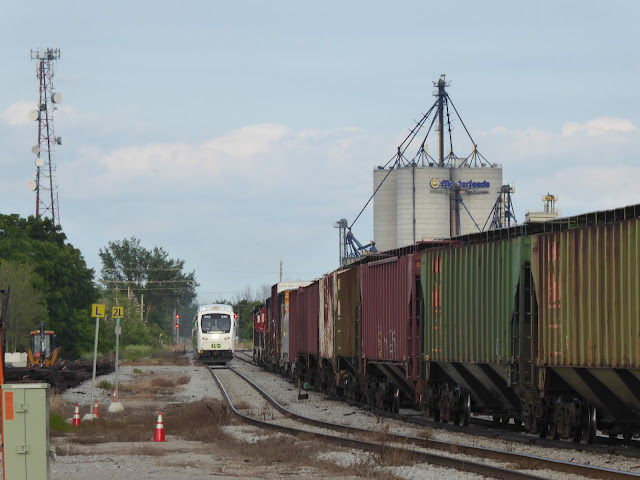Fallowfield Station is 21 years old this year and, for its entire history, has drawn confusion over its name. Look through old news coverage of the station when it opened in 2002 and you will see that people wrote letters to the editor of the Ottawa Citizen, asking Via Rail to change the name of the station to Barrhaven, where it is located in the southwest of Ottawa's urban area.
There are a few interesting points to consider when considering why the station is named Fallowfield. The most important point is that the station is technically located on Fallowfield Road, which is an arterial road on the northern edge of the massive suburb. That is a reasonable enough explanation on its face, but it's not that simple. Those who know their geography in the Ottawa area know that a small rural village, located between Bells Corners and Richmond, is called Fallowfield. This beautiful rural community traces its routes back to the 1870s. It boasts a beautiful old stone church, St. Patrick's, which sits atop Steeple Hill (naturally), just off Old Richmond Road.
For our purposes, it's important to note that the Fallowfield community is located nine kilometres away from the actual station that bears its name. Using St. Patrick's as a reference point, Google Maps shows that the distance from the Steeple Hill area, where many Fallowfield residents live, to the station is 9.1 kilometres. For Ottawa area residents, this is no longer an issue, as most people understand the station and the community are not the same thing, but for people unfamiliar with this city, it begs the question why the station would be named Fallowfield.
The second point to consider is that the station's name is not without precedent. Consider that Via Rail's suburban station in Scarborough is called Guildwood, although in that case, the station is located in a community by the name Guildwood, that eventually was subsumed by Scarborough. Also, Via Rail's station in Hamilton is called Aldershot. Both of these names predate Via Rail, so neither of these unique choices can be credited to Via. But for our purposes, there is historical precedence for giving a station a name that does not align with the community it serves.
It's important to note that railways have often located their stations in areas that are most advantageous to them, rather than what is convenient to the town they serve. This was often done to discourage land speculators from benefiting from selling overpriced land in an area where a railway was expected to be built. In some cases, a station was built along a rail line that bypassed the nearest town altogether. Look at Gananoque's station in Cheeseborough as an example. In the case of this town, a branchline was opened to the station so the town wouldn't be left behind. Also, look in Ottawa's south end, where the old CP Prescott Subdivision as once located. Consider how far the Manotick Station area is, where the line was went through, from the actual community of Manotick.
In the case of Fallowfield Station, the name is not the product of Via Rail shenanigans. It was the product of an OC Transpo suburban pack and ride facility for its city buses. The park and ride facility was built at the corner of Fallowfield Road and Woodroffe Avenue before Via Rail began to consider opening up its station.
This is where the bizarre railway policy in Ottawa municipal politics enters the picture. When Nepean city council began lobbying for a train station in Barrhaven, one idea was that the Via station would be a useful resource for people in the west end of the Ottawa urban area, who didn't want to travel to the Ottawa Station, east of Ottawa's downtown to catch a train to Toronto.
But even more than the convenience factor for west end residents, the Via station was seen as an important potential link in a commuter railway network using existing rails in the city. Look at the news coverage from the late 1990s and early 2000s and you will read about numerous local politicians extolling the virtues of a multi-modal commuter station that linked together buses, commuter trains and Via Rail. The idea was for the station to be a GO station, in addition to a link on the Via Rail network.
When I was researching the history of the station, there it was in black in while: proof that this city once had a coherent, reasonable commuter railway policy that included the common sense notion of using the infrastructure in place to move people to and from the suburbs into the core using existing rail.
Of course, those notions of using existing rails were repeatedly dismissed by so-called progressive visions of a more European rail network, using electric light rail vehicles on a new right-of-way on an east-west axis. We know the rest of that story, which is still sadly unfolding today.
So, why Fallowfield Station? Well, because at one point, Fallowfield Station as supposed to double as a commuter rail station for OC Transpo, so it needed to have the same name as the OC Transpo park and ride bus station that was already in place.
When successive councils repeatedly quashed the idea of using existing rails to serve as a basis for commuter rail service in the city, the name for Via Rail's Barrhaven station became even more questionable. Eventually a decision was reached to include the name Barrhaven in parenthesis on the station signs.
As Paul Harvey used to say: Now you know, the rest of the story.













.png)